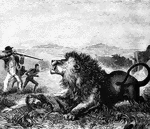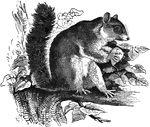
Canada Lynx
"The Canada Lynx of the Indians, has a round, broad head, large eyes, strong teeth, ears acute and tipped…
Fort Clinch
"Exterior view of Fort Clinch, on Amelia Island, Fla., commanding the Harbor of Fernandina, captured…
Fort Clinch
"Interior view of Fort Clinch, on Amelia Island, Fla., commanding the Harbor of Fernandina, captured…
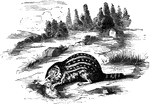
Leopard Spermophile
"The leopard spermophile is one of the most beautiful of all striped species of spermophile. It resembles…

Rock Cavy
"In this animal, the fur is soft, its general hue gray, tinted with rufous on the hinder art of the…
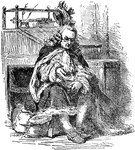
King in the Counting-House
Sing a Song of Sixpence. The king was in his counting-house, counting out his money.

Black Agouti
"Is considerably smaller than the common agouti, being about the size of a rabbit, while the species…
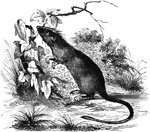
Crested Nelomys
"In its size and hte form of its tail it bears no inconsiderable resemblance to the common rat, the…

Chinchillas
"It is of a grayish color, and sufficiently long for spinning. The little animal which is produces it…

Confederate Cavalry
"Confederate cavalry driving stragglers and skulkers back to their duty at the Battle of Antietam. One…

John Gilpin
Gilpin speaks to his horse. "I am in haste to dine; 'Twas for your pleasure you came here, You shall…
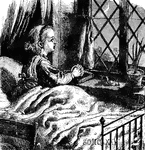
Twinkle, Twinkle, Little Star
Twinkle, twinkle, little star. How I wonder what you are! Up above the world so high. Like a diamond…
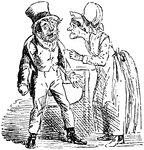
Little Old Couple
"My little old man and I fell out; I'll tell you what 't was all about,--I had money and he had none,…

Little Betty Blue
"Little Betty Blue Lost her holiday shoe. What can little Betty do? Give her another To match the other,…

Hilton Head
"Exterior view of fortifications erected by the Federal troops at Hilton Head, Port Royal. S. C. Hilton…

Castle Garden
"Reception of Brigadier General Corcoran by Mayor Opdyke and the citizens of New York, at Castle Garden,…

Battle of Baker's Creek
"Battle of Baker's Creek, May 16th, 1862- Defeat of the Confederates under Pemberton, by General Grant.…

Camp Douglas
"Bird's-eye view of Camp Douglas, Chicago, Ill., used for the detention of Confederate prisoners in…

Tybee Island
"Tybee Island, Savannah River, Ga.- Views of the lighthouse and barracks- destruction of the lighthouse…

General Hospital Interior
"United States General Hospital, Hilton Head, S. C., interior. The United States General Hospital at…
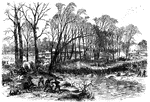
Battle of Stone River
"Battle of Stone River, Tenn. The decisive charge of General Negley's division across the river- the…

Lake Providence
"Lake Providence, La., headquarters of General McPherson and the Federal division under his command.…

Battle of Stone River
"Battle of Stone River, Tenn. Decisive charge and capture of Byrne's Confederate battery by the Seventy-eighth…

Battle of Gettysburg
"Battle of Gettysburg, Cemetery Hill during the attack of the Confederates, Thursday evening, July 2nd,…
Hundred Mile Prairie
"Camp life in the West. During one of the pauses in the active part of the Missouri campaign our special…

Harrison's Landing
"Harrison's Landing, James River, Va. The commissariat depot and base of operations of General McClellan…

Battle of Chancellorsville
"Battle of Chancellorsville, Va., Friday, May 1st, 1863. We give a fine sketch of the point where the…

Battle of Chancellorsville
"Battle of Chancellorsville, Va. Attack on General Sedgwick's Corps. on Monday, May 4th, 1863, at 5…

Falmouth
"Federal troops marching back into Falmouth after the Battle of Chancellorsville."— Frank Leslie,…

Battle of Blue Ridge Pass
"Battle of Blue Ridge Pass, Sunday, September 14th, 1862- the first Federal victory in Maryland. On…

Battle of Gettysburg
"Battle of Gettysburg- charge of the Confederates on Cemetery Hill, Thursday evening, July 2nd, 1863.…

Attack on Confederate Works
"Siege of Vicksburg, attack on the Confederate Works, May 22nd, 1863. Our sketch represents the terrible…

Confederate Batteries
"Fredericksburg, Va., and the Confederate batteries and pickets, as seen from Falmouth Heights, headquarters…

Battle of Gettysburg
"Battle of Gettysburg, Thursday evening, July 2nd, 1863, as seen from Rocky Hill, on Meade's left. Our…

Confederate rams
"Confederate rams from Charleston Harbor attacking the Federal blockading squadron, January 31st, 1863.…

Battle of Chickamauga
"Battle of Chickamauga- repulse of the Confederates at Crawfish Creek. We present a most interesting…

War in Virginia
"The War in Virginia. Capture of three Confederate guns, near Culpepper, by General Custer's cavalry…
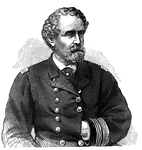
Rear Admiral James Alden
"Rear Admiral Alden, born in Portland, Me., March 31st, 1810, died in San Francisco, Cal., February…
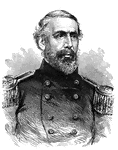
General J. H. Hobart Ward
"General Ward, born in New York city, June 17th, 1823, was educated at Trinity Collegiate School; enlisted…
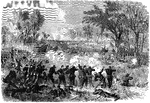
Battle of Chancellorsville
"Battle of Chancellorsville, Sunday, May 3rd, 1863. General Hooker repulsing the attack of the enemy.…

Waterhouse's Battery
"Waterhouse's Battery, Sherman's Corps, before Vicksburg. The interior view of Waterhouse's battery,…
Government Buildings - Contraband Camp
"Government buildings for 'Contrabands,' erected at Hilton Head, S. C., in 1862. Among the many singular…

Centreville
"View of the town of Centreville, Va., with the battlefield of Bull Run, Bull Run Mountains, Thoroughfare…

Loudon Heights
"View from Loudon Heights, Va., showing Harper's Ferry, Maryland Heights, Bolivar, etc. Harper's Ferry,…

General Rufus King
"General King, born in New York city, January 26th, 1814, died there, October 13th, 1876, was graduated…
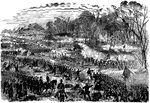
Battle of Champion Hills
"Battle of Champion Hills, May 16th, 1863- the formidable position of General Pemberton carried by Generals…

Fort Walker
"View from the interior of Fort Walker, Hilton Head, S. C. looking inland, showing the defenses from…

Northern Armies
"The enthusiasm of the Northern armies- re-enlistment of the Seventeenth Army Corps. Financial tests…

Battle of Grand Coteau
"Battle of Grand Coteau, La., November 3rd, furious attack on the Sixtieth Indiana, Colonel Owen. On…

Battle of Chickamauga
"Battle of Chickamauga, Ga., September 19th-20th, 1863, between Generals Rosecrans and Bragg. Our sketch…
War in Virginia
"The war in Virginia. Battery on the left of the enemy's line, in front of Petersburg, captured by the…
!["Presentation of colors to the Twentieth United States [African American] Infantry, Colonel Bartram, at the Union League Clubhouse, New York, March 5th, 1864. The Twentieth Regiment, United States [African American] Troops, left Riker's Island at nine o'clock on the 5th of March, 1864, on board the steamer <em>John Romer</em>, and were conveyed to the foot of Twenty-first Street, East River, New York, where they were disembarked and formed in regimental line, and marched to Union Square, arriving in front of the Union League Clubhouse at one o'clock. A vast crowd of citizens, of every shade of color and every phase of social and political life, filled the square and streets, and every door, window, veranda, tree and housetop that commanded a view of the scene was peopled with spectators. Over the entrance of the clubhouse was a large platform, ornamented with flags and filled with ladies. In the street was another platform, tastefully decorated and occupied by prominent citizens. From the stand the colors were presented by President King of Columbia College, who addressed them with warmth and eloquence. After the presentation ceremony was over the men stacked arms and partook of a collation provided for them."— Frank Leslie, 1896](https://etc.usf.edu/clipart/11700/11749/presentcolor_11749_mth.gif)
Presentation of Colors
"Presentation of colors to the Twentieth United States [African American] Infantry, Colonel Bartram,…

Horseshoeing
"Horseshoeing in the army. Not like the country blacksmith, by the highroad upon the skirt of the village,…

Red River
"The war on the Red River. Admiral Porter's fleet passing through Colonel Bailey's Dam, above Alexandria,…

Grant's Campaign
"Grant's Campaign in Virginia. The Battle of Bethesda Church, between Crawford's division, Fifth Corps,…
